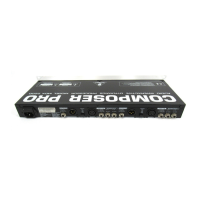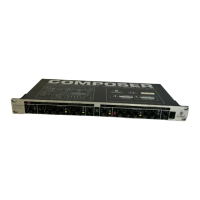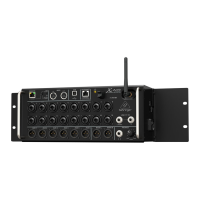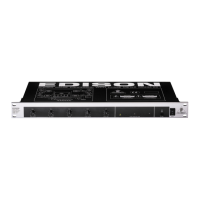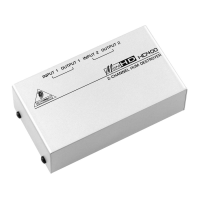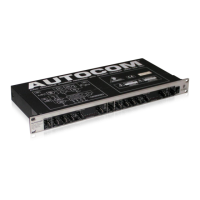5 MULTICOM PRO-XL MDX4600/PRO-XL MDX2600/AUTOCOM PRO-XL MDX1600 User Manual
1. Introduction
With this new dynamics processor from the PRO-XL series you have acquired
an extremely powerful and universal compressor which unites in one compact
device all of those dynamics control functions that are most frequently used
in practice: each channel has an independent compressor/limiter, expander/
gate and peak limiter. Thus, virtually all dynamics processing problems can be
remedied with little eort.
Future-oriented BEHRINGER technology
The new PRO-XL dynamics processors from BEHRINGER feature several innovative
circuit designs, making them top-class dynamics processing equipment.
Compared to their predecessors, they now have improvements such as the
de-esser, which allows you to eectively suppress disturbing hiss noise
(COMPOSERPRO-XL), additional LED displays to set the de-esser levels, plus a
switchable enhancer.
The AUTOCOM PRO-XL not only includes an enhancer, but also a switchable
de-esser and a peak limiter, which has already proved its versatility in the
COMPOSER PRO.
The BEHRINGER MULTICOM PRO-XL has been upgraded with an expander/
noise gate plus enhancer. Additionally, we have managed to improve its audio
properties even further—in combination with a revised circuit design.
To give you the best operational reliability possible, we manufacture our
products in accordance with the highest quality standards known in the industry.
Additionally the dynamic processors are manufactured under ISO9000 certied
manage ment system.
VAD (Voice-Adaptive) De-esser
The COMPOSER PRO-XL and AUTOCOM PRO-XL incorporate a newly designed
de-esser circuit specically adapted to process the critical range of treble
frequencies. Hiss noise on vocal tracks often contains high levels, giving the
signals a rather edgy, unpleasant sound. The de-esser responds to those
frequency ranges in which hiss noise usually occurs and limits the overall signal
level as soon as the audio signal is aected by excessive energy density in this
range. Unlike equalizers, however, it does not impair the frequency response of
the signal. In this way, intelligibility in low-level passages is perfectly preserved,
and you can even boost the treble range with a good equalizer. The sound
becomes transparent and fresh, while the de-esser prevents hiss noise from
becoming too dominant and disturbing the overall sound image.
IDE (Interactive Dynamic) Enhancer
Probably the best known negative side eect of a compressor is the “dull” and
“compressed” sound that is likely to result from the processing of complex
program material. Low-frequency instruments usually produce the highest signal
energy and hence make the compressor reduce the overall level. Any instrument
in the higher frequency ranges concurrently played also has its level reduced,
which leads to a “compressed” overall sound.
The dynamic enhancer provides the solution to this problem, enabling you to
make up specically for the compression-induced loss of treble energy. Since the
enhancer can detect the amount of compression applied, it does not change the
sound image as long as the signals remain uncompressed. No treble energy is
lost, even when complex mix-down material is processed.
ATS (Authentic Tube Simulation) circuitry
Even today, the warm, expressive and transparent tonal character of electronic
tubes is a real “classic”. We proudly present the COMPOSER PRO-XL and its
high-tech circuit design enabling the authentic reproduction of this legendary
sound, and at the same time avoiding all of the technical drawbacks that
go along with tube technology. Owing to state-of-the-art semi-conductor
technology, thereis no sound deterioration caused by tube ageing, there are
no heat problems and no maintenance required at all. All that remains is the
advantage of tube technology: its distinctive sound!
IKA (Interactive Knee Adaptation) Compressor
Our proven IKA (Interactive Knee Adaptation) circuit successfully combines
the “hard knee” compressor concept with the “soft knee” characteristic.
Thisprogram-dependent control characteristic makes it possible to both provide
an “inaudible” and musical program compression and allows for creative and
ecient dynamics processing.
IRC (Interactive Ratio Control) Expander
A fundamental problem when using a compressor is the fact that the basic
noise oor depends on the amount of compression applied, i.e. it is amplied
maximally in low-level passages and breaks in the music (compressor noise).
To eliminate this problem, compressors are usually equipped with additional
expander or gate circuitry, simply fading out the noise during breaks.
The dynamics processors from the PRO-XL Series feature our IRC (Interactive
Ratio Control) expander, whose ratio setting changes automatically with the
program material. The result is an expander that can be set quickly and easily,
and does not cut o low-level wanted signals (e.g. the rst or last syllable of
a word in a vocal track). With the new IRC circuit, the expander/gate section
of the BEHRINGER COMPOSER PRO-XL MDX2600, AUTOCOM PRO-XL MDX1600
and MULTICOM PRO-XL MDX4600 can be used as an independent device to
eliminate any kind of interference, thus giving you almost unlimited exibility
ofapplication.
IGC (Interactive Gain Control) Peak Limiter
Another outstanding feature of BEHRINGER dynamics processors is the IGC
(Interactive Gain Control) limiter, an intelligent combination of a clipper and
program limiter. The clipper comes in as soon as an adjustable threshold is
exceeded and abruptly limits the signal gain. However, if the limiter threshold
is exceeded for longer than a few milliseconds, the ICG circuit is activated
automatically and reduces the gain of the overall output signal, so that
audible distor-tion is eliminated (program limiter). When the signal drops
below threshold again, its level is restored to its original value after about one
second. This IGC feature is an extremely usefull tool for both live applications
(e.g. speaker protection) and digital processing, in which excess levels lead to
unpleasantdistortion.
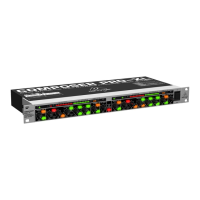
